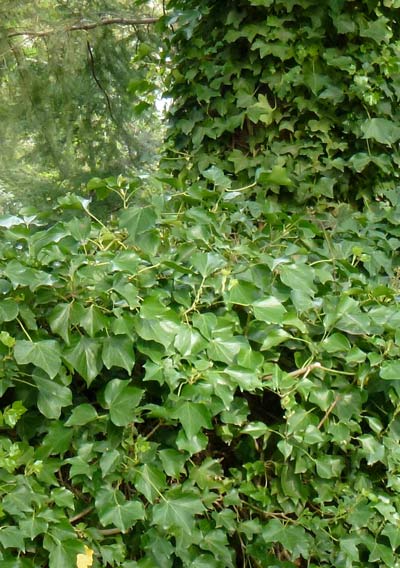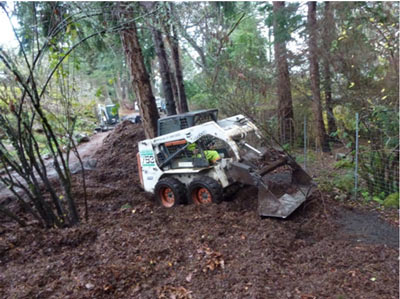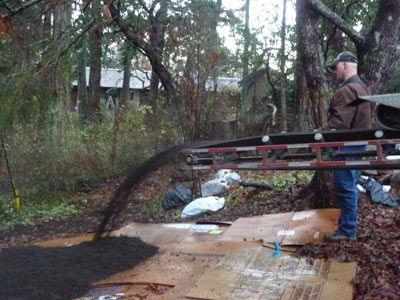UVic student Nathalie Vogel submitted the following narrative about PCAF Project 976, the Restoration of Robin Lane. HCTF contributed over $5000 to this project, which involved more than twenty volunteers removing invasives and restoring native plants to a former Garry Oak site in Saanich, BC. Thank you, Nathalie, for sharing your story.
 What do you get when you combine sunshine, fresh lemongrass tea, Salal, Oregon grape, some restoration veterans and the smell of earth in your nostrils? A thoroughly enjoyable afternoon spent at Robin Lane, sharing in ecological restoration, and bodily rejuvenation. Fellow classmate and restoration rookie Jenna and I had the pleasure of sharing an afternoon with two ladies who know this business like the dirt under their nails. Sylvia Samborski and Louise Goulet have been working with plants for decades – both through their careers as naturalists and biologist/teachers and now through their hobbies of gardening, restoration and the continued desire to learn. The fortune was truly ours that afternoon as the women passed along words of wisdom and knowledge about plants and life – the line sometimes blurring between the two.
What do you get when you combine sunshine, fresh lemongrass tea, Salal, Oregon grape, some restoration veterans and the smell of earth in your nostrils? A thoroughly enjoyable afternoon spent at Robin Lane, sharing in ecological restoration, and bodily rejuvenation. Fellow classmate and restoration rookie Jenna and I had the pleasure of sharing an afternoon with two ladies who know this business like the dirt under their nails. Sylvia Samborski and Louise Goulet have been working with plants for decades – both through their careers as naturalists and biologist/teachers and now through their hobbies of gardening, restoration and the continued desire to learn. The fortune was truly ours that afternoon as the women passed along words of wisdom and knowledge about plants and life – the line sometimes blurring between the two.
Robin Lane, our Eden of escape on that brisk January afternoon, is a piece of public land located in Saanich on Vancouver Island. Sylvia and her husband Ron took it upon themselves to restore some love and biodiversity into this piece of abandoned land and return it to the flourishing Garry Oak ecosystem that it once was. The process started with hours of devotion by Sylvia, Ron and their enthusiastic group of friends to remove all invasive species – which made up most of the vegetative cover in the area. The next step in the process was to rebuild the nutrients and minerals within the soil with chopped leaves from the city’s annual street leaf pickup program, spreading the leaf mulch with a small bobcat. Plant roots need soil not only to anchor themselves, but also to obtain nutrients, water and oxygen. Taking into account the historical status of this area as a Garry Oak ecosystem, consideration of ideal soil types for this particular habitat was necessary. Robin Lane is the perfect example of what was once a deep soil Garry Oak site – formerly rich with a variety of shrubs, trees, flowers and grasses. Sadly, these sites have all but disappeared as the rich hearty soil was ideal for agriculture and future urban development. It is only through the tireless work of devoted groups of people – like Sylvia and Ron- that these areas can be potentially restored to their former status and function.
During our afternoon at Robin Lane we engaged in our fair share of soil SOS as we added a concoction of weird and wonderful substances to each plant that we planted. The area had already been prepped over the last couple of months – a process involving layers of cardboard sheet mulch, Garry Oak and Bigleaf Maple leaf mulch, topped with sandy soil to increase permeability and drainage so that the plants don’t drown when it rains. Because the roots of the plants wouldn’t be enclosed by sandy soil (the layer of mulch underneath was so thick) we started by digging holes for plants and filling them partially with sandy top soil. Then we added a mixture of compost, bonemeal and more topsoil–all the ingredients necessary for your juiced up plant protein shake. Each of these ingredients plays a special role in increasing the nutrient content of the soil and ensuring the continued success of the ecosystem. The bonemeal aids in ensuring enhanced root growth. The native plants that we got to work with that afternoon included Salal, Red flowering current, Evergreen Huckleberry, Red-osier dogwood, Sword fern, Oregon grape (tall and dull) and Indian plum.


Following the guidance of restorationist, and garden designer extraordinaire, Louise, we placed the plants in a “natural” but still aesthetically pleasing manner throughout the area. Future picnic sites were taken into account as we made room for small clearings and deftly placed boulders, a small pathway lined by stones meandering through the lane. Not used to the patience of planting, I at times found it hard to picture the haven these tiny shrubs would one day create. Sylvia and Louise made that visualization easier however, as they animatedly discussed the different species, the various placement options and their excitement of sharing this site with as many people as possible in both the near and distant future. Amid digging, Sylvia recounted how her mother used to explain the difference between being dirty, and just being covered in “good clean dirt”. They shared with us stories of their past planting endeavours, their growing families and words of wisdom from the “workforce”. Louise kept us in fits of laughter as she recounted her experiences as the only woman working in her biological consulting group in northern Canada, and the spunk that it took to keep her there.
The afternoon finished with a steaming pot of homemade lemongrass tea accompanied by mandarin oranges and baking courtesy of Sylvia’s grandchildren. Sylvia welcomed us into her home and shared all her favourite field guides, recommending Pojar and Mackinnon’s “Plants of the Pacific Northwest Coast” as her and Louise’s top pick.
All in all I would say the afternoon did as much to restore my soul as it did to restore Robin Lane. The enjoyment of spending time outside with your hands and feet in the earth, swapping stories and shovelfuls of soil is therapeutic in a way that cannot be explained. For me the restoration of the Garry Oak ecosystem itself was simply an added bonus. I would recommend a restoration volunteer excursion to anyone and everyone who will listen. Connecting with the community, meeting inspiring individuals, learning about native plants, giving back to the earth, the list of benefits goes on and on. But in the end what really got me, was getting all that good clean dirt ingrained in my nail beds.






